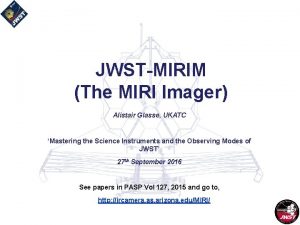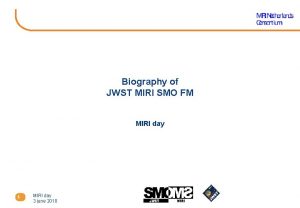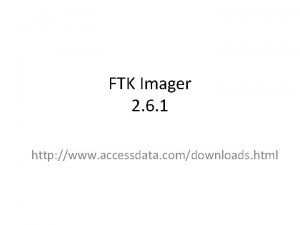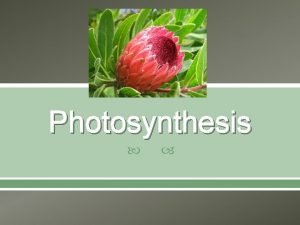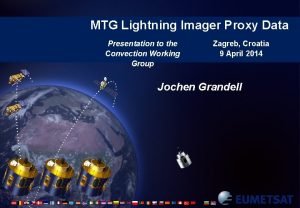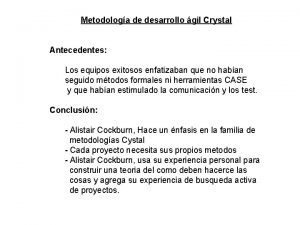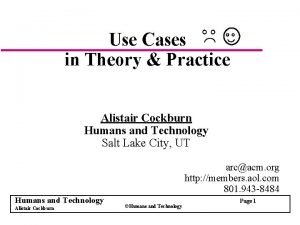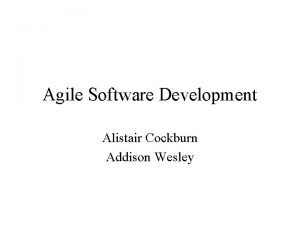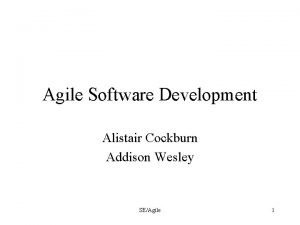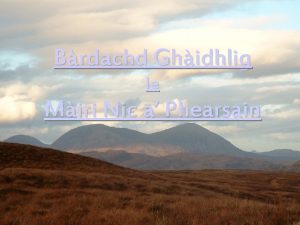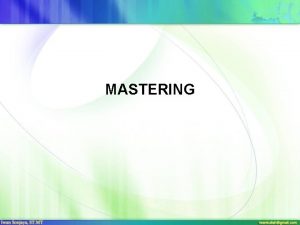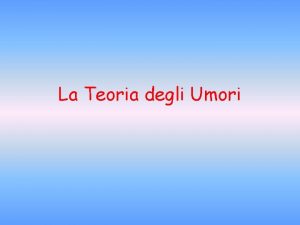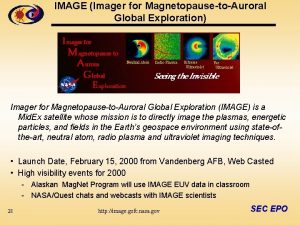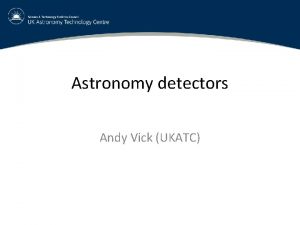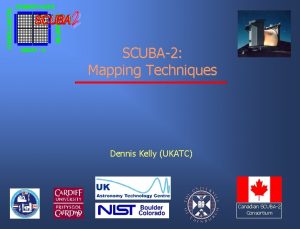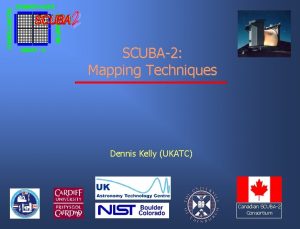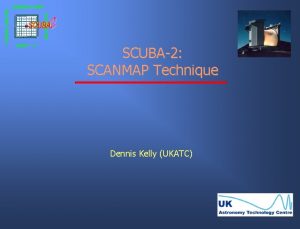JWSTMIRIM The MIRI Imager Alistair Glasse UKATC Mastering















- Slides: 15

JWST-MIRIM (The MIRI Imager) Alistair Glasse, UKATC ‘Mastering the Science Instruments and the Observing Modes of JWST’ 27 th September 2016 See papers in PASP Vol 127, 2015 and go to, http: //ircamera. as. arizona. edu/MIRI/

Summary l Designed, built and tested at CEA/Saclay. l Diffraction limited image quality, fully Nyquist sampled longward of l = 7 mm. l 0. 11 arcseconds / pixel l Background limited sensitivity. l High throughput. l Low distortion. l Stable and well defined boresight.

Reminder of MIRI capabilities l MIRI optical configurations map onto the JWST focal plane as follows, 4 QPM Coronagraphs 10. 65µm 11. 4µm 15. 5µm 24 x 24 arcsec. Imager 75 x 113 arcsec Low Resolution Spectrometer Slit 5 x 0. 6 arcsec Medium Resolution Spectrometer > 3. 5 x 3. 5 arcsec (arcminutes on sky) Lyot Coronagraph Mask 23 mm 30” x 30” l Light falling in the imager field (and the Lyot mask) only sees the filter selected in the MIRI filter wheel.

PCE (Photon Conversion Efficiency) l MIRI PCE is the fraction of photons crossing the MIRI Entrance Focal Plane which are detected as photoelectrons. (It does not include photoelectric gain/quantum yield). l It includes a factor of 0. 8 to account for Beginning Of Life contamination.

Observatory background and bright source sensitivity l MIRI’s faint source sensitivity limit is set by shot noise on the background radiation from the sky and telescope optics. l This generates a signal at the detector (el / second) which can be compared with the signal collected from a 1 milli. Jansky point source. 104 103 Photocurrent [electrons sec-1] Background flux [MJy sterad-1] 104 Total 102 JWST 10 Zodiacal light 1 0. 1 10 20 Wavelength [mm] 30 103 1 m. Jy point source Sky + JWST background 102 10 1 10 20 Wavelength [mm] l For the imager, the SNR of an observation will be dominated by the source’s own flux for sources brighter than > 1 m. Jy at short wavelengths. 30

Sensitivity and saturation limits l These sensitivity limits (below) apply to faint sources observed with the FULL imager field of view. l They assume a photometric aperture of radius, rphot = 0. 42 (l / 10 mm) (Note: The full width at half maximum intensity (FWHM) of the point spread function (PSF) is d. FWHM = 0. 32 (l / 10 mm). Filter Name F 560 W F 770 W F 1000 W F 1130 W F 1280 W F 1500 W F 1800 W F 2100 W F 2550 W Wavelength Bandwidth Sensitivity S/N = 10 in 10, 000 second on-chip integration. Point Source Extended Source Point Source milli. Jansky µm µm micro. Jansky 5. 6 7. 7 10. 0 11. 3 12. 8 15. 0 18. 0 21. 0 25. 5 1. 2 2. 0 0. 7 2. 4 3. 0 5. 0 4. 0 0. 16 0. 25 0. 54 1. 35 0. 84 1. 39 3. 46 7. 09 26. 2 * The bright limit for extended targets is given by Fbright_ext = Fbright_point x fbr_pix_imager / Apix , where micro. Jansky arcsec-2 0. 89 0. 77 0. 99 1. 89 0. 88 1. 11 1. 9 2. 9 7. 3 Saturation Limit (Fbright) 13 7 15 68 27 36 65 66 195 Extended Source* milli. Jansky arcsec-2 140 75 103 366 113 110 138 103 206

Update to Sensitivity Predictions l Recent updates to the model of the JWST thermal background (Lightsey) and the expectation of a quantum yield ‘G’ > 1 (Rieke) will require us to revise the sensitivity model at short wavelengths (for all MIRI modes). l We have calculated the impact on sensitivity and saturation limit (for the point source case) to give the values we will aim to have implemented by the ETC. Filter Name Wavelength Bandwidth Sensitivity S/N = 10 in 10, 000 second on-chip integration. Scale PASP ETC Target factor micro. Jansky Saturation Limit (Fbright) Scale factor PASP ETC Target µm µm milli. Jansky F 560 W 5. 6 1. 2 1. 170 0. 16 0. 18 1. 19 13 11 F 770 W 7. 7 2. 2 1. 118 0. 25 0. 28 1. 12 7 6 F 1000 W 10. 0 2. 0 1. 088 0. 54 0. 59 1. 06 15 14 F 1130 W 11. 3 0. 7 1. 087 1. 35 1. 46 1. 04 68 65 F 1280 W 12. 8 2. 4 1. 126 0. 84 0. 95 1. 01 27 27 F 1500 W 15. 0 3. 0 1. 163 1. 39 1. 62 1. 00 36 36 F 1800 W 18. 0 3. 0 1. 122 3. 46 3. 88 1. 00 65 65 F 2100 W 21. 0 5. 0 1. 065 7. 09 7. 55 1. 00 66 66 F 2550 W 25. 5 4. 0 1. 028 26. 2 26. 9 1. 00 195

A note on saturation and readout patterns l The MIRI calibration and pipeline reduction strategies are optimised for a minimum of 5 groups/frames per integration. l The quoted saturation limits are based on the point source flux which will fill the brightest pixel to 60 % of the hard saturation limit, using an integration time of 5. 6 seconds, comprising a reset followed by 2 FULL frame reads. (to measure the slope. ) integrati on time 2. 8 sec Hard Saturation Limit Pixel 1024, 1024 Signal [DN] Pixel 1, 1 Pixel Address Photon flux / Photocurre nt FRAM E RESET READ Nominal Bright Source Limit time Measure d respons e l The potential use of 2 (or 1) frames per integration is under discussion at/with STSc. I. l The preferred mitigation for bright sources with optimum noise (but reduced field of view) is to use subarrays. . .

Subarrays for imaging bright targets l The use of subarrays with the imager allows us to increase the bright source / saturation limit at the cost of a reduced field of view. Frame time [sec] Gain in bright source limit FULL 2. 775 1. 00 BRIGHTSKY 0. 865 3. 21 SUB 256 0. 300 9. 25 SUB 128 0. 119 23. 32 SUB 64 0. 085 32. 65 MASKLYOT 0. 324 8. 56 MASK 1550 0. 240 11. 56 MASK 1140 0. 240 11. 56 MASK 1065 0. 240 11. 56 SLITLESSPRISM 0. 159 17. 45 Subarray l For example, the SUB 128 subarray will have a field of 14 x 14 arcseconds and can measure point sources through the F 1280 W filter with fluxes up to 0. 027 Jy x 23. 32 = 0. 6 Jansky without approaching saturation.

Image sampling and Encircled Energy l What do the image/sampling dimensions look like in practice? n This is an F 560 W test image from GSFC testing (CV 3 campaign, 2013) • Linear image scale. • The FWHM of the image is ~ 1. 6 pixels. (> 2 pixels for l > 7 microns). • Log 10 image scale (3 orders of magnitude). • The photometric aperture is predicted to include ~ 58 % of the flux from a point source at F 560 W. Fraction of point source flux included in photometric aperture Best Case Nominal Worst case (Dfocus = 5 mm Dpupil = 2 %, etc) 14 pixels = 1. 54 arcseconds Wavelength [mm]

Image quality l MIRI’s PSF is well described at long wavelengths by the JWST’s diffraction profile. l At short wavelengths (F 560 W, F 770 W filters) a cruciform pattern appears, at a level comparable to the telescope diffraction spikes. Identified with scattering in the detector. l A model has been developed using PSF and out-of-field straylight test data which predicts that 22 % of the point source light at F 560 W is scattered into the cross (11 % for F 770 W). CV 2 F 560 W image of OSIM IR LED Model JWST diffraction limited PSF Model MIRI PSF, including scattering.

Field distortion l Measured using a 7600 point source grid target plate with at CEA. l The pixel area projected onto JWST focal plane varies by < 4 %.

Dither Patterns from the MIRI OCD. l In order to achieve the optimum sensitive performance from MIRI’s detectors, the target must be moved on the detector every few minutes a distance > several l / D. (several = 6). l In general, the observations will be differenced to remove the background level. This will add noise (√ 2 for faint sources). This will be budgeted by the ETC. l A range of patterns will be provided, consistent with the support of self-calibration. (measurement of flat field and background levels using ‘empty’ parts of the science data set). l In general they are scaleable and will include a simple 2 point dither.

MIRIM Strengths and Weaknesses l Strengths n Built by heroes. n The MIRIM detector has great cosmetics (less than 300 dead, hot or noisy pixels in the science field). n Does everything we asked for in 2003. l Weaknesses n Columns 385/286 are shorted together. n That’s it.

End
